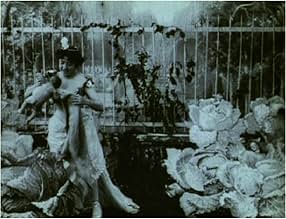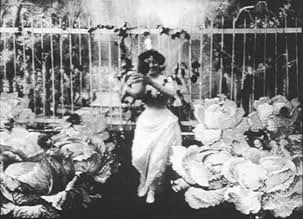IMDb RATING
5.4/10
1.5K
YOUR RATING
Fantasy tale involving a fairy who can produce and deliver babies coming out of cabbages. Gently moving through the cabbages and using of lovely gestures, she takes one baby out of there, th... Read allFantasy tale involving a fairy who can produce and deliver babies coming out of cabbages. Gently moving through the cabbages and using of lovely gestures, she takes one baby out of there, then makes more magic and delivers two more.Fantasy tale involving a fairy who can produce and deliver babies coming out of cabbages. Gently moving through the cabbages and using of lovely gestures, she takes one baby out of there, then makes more magic and delivers two more.
- Director
- Writer
- Stars
- Director
- Writer
- All cast & crew
- Production, box office & more at IMDbPro
Storyline
Did you know
- TriviaConsidered to be the first ever fiction film by historians.
- ConnectionsFeatured in Be Natural: The Untold Story of Alice Guy-Blaché (2018)
Featured review
You know where babies come from, but do you know the real origins of movies? Contrary to Internet folklore, movies weren't actually born and reproduced of YouTube--not directly or originally, at least. Apparently, that's how many people, including the reviewers on this site, came by this early film, though. Consequently, some lose sense of the picture's meaning and origins. The birds and the bees of the matter, however, is that "The Cabbage-Patch Fairy" was, first, conceived by Alice Guy-Blaché. She related the story of her creation in interviews and her memoir decades after the fact, although her telling of it hasn't quite aligned with the surviving historical record. The earliest cabbage-patch film we have today was rediscovered together on a 35mm reel with other Gaumont productions at the Swedish Film Archive in the late 1990s. Later, it made its way onto DVD, such as in part of the Kino Gaumont set and, from here, ripped and uploaded as video to the web. Along the way, however, these posters ignored the usual dating of the film as c.1900 in favor of trying to substantiate Guy-Blaché's later claims--or, more likely, they chose 1896 as a more sensational date. Thus, it may be proclaimed the first film made by a woman, or, even more preposterously, as the first story film, or some such primacy nonsense. Yet, the truth is it likely isn't Guy's first film (even if it is hers), although it may be a remake of a hypothetical first cabbage-patch film she made in 1896, and neither of those films would be the first story film, anyways--even if this one weren't in the cinema-of-attractions mode as opposed to more of a proto-narrative.
On the other hand, leading historian of Guy, Alison McMahan (in her book, "Alice Guy Blaché: Lost Visionary of the Cinema") makes the best case for this possibly being the 1896 film, as, perhaps, reproduced from an original 58mm print (the size for the camera by Georges Demenÿ that Gaumont first employed). Theoretically, then, as McMahan argues, the cabbage patch set-up based in folklore (like the one involving storks) may be viewed as a demonstration film, with the cabbages standing in for Gaumont's advertising of their cameras and with the babies as the films they make. But even McMahan hedges her bets by suggesting it may be a remake, too. The documentary "Be Natural: The Untold Story of Alice Guy-Blaché" goes so far as to claim it a remake of the now-lost hypothetical 1896 production--although no evidence is offered for this assertion. Others, such as Jane M. Gaines (author of "Pink-Slipped: What Happened to Women in the Silent Film Industry") and Joan Simon ("Alice Guy Blaché: Cinema Pioneer"), meanwhile, have led the way in otherwise forming a consensus around a date c.1900, which film preservationists and such home-video makers as Kino followed for DVD dating. After all, the earliest listing of a cabbage-patch film in surviving Gaumont catalogues, where the film was singled out as "a great success," suggests a 1900 dating. Moreover, the cabbage-patch film that Guy-Blaché described in her later years, besides the 1896 date, more closely resembles a 1902 film of hers, "Midwife to the Upper Class" (1902), which, indeed, is a two-shot narrative film. A photograph of Guy with a couple actors that in the past has erroneously been attributed to and been held up as evidence for an 1896 film, indeed, is from this 1902 production.
Indeed, remakes were common in the cabbage patch of early cinema and not only to rework a familiar narrative, but also as replacement for popular films, such as this one, whose negatives were worn out by the film duplication processes of the era. The prior fiction film, "The Gardener" (1895), for instance, was reborn a few times by the Lumière brothers and other studios. As to establishing Guy's maternity of this earliest surviving cabbage-patch film, it seems likely given that she made two later films involving cabbage-patch babies, the aforementioned 1902 production and a scene from "Madame's Cravings" (1906). Even if not the first film made by her, let alone the first narrative one, "The Cabbage-Patch Fairy" is an interesting piece of early cinema, which I'll discuss in my review under the entry for La fée aux choux, ou la naissance des enfants (1900), the 1900 version of this same, one and only, film we've seen, whether dated 1896 or to 1900.
On the other hand, leading historian of Guy, Alison McMahan (in her book, "Alice Guy Blaché: Lost Visionary of the Cinema") makes the best case for this possibly being the 1896 film, as, perhaps, reproduced from an original 58mm print (the size for the camera by Georges Demenÿ that Gaumont first employed). Theoretically, then, as McMahan argues, the cabbage patch set-up based in folklore (like the one involving storks) may be viewed as a demonstration film, with the cabbages standing in for Gaumont's advertising of their cameras and with the babies as the films they make. But even McMahan hedges her bets by suggesting it may be a remake, too. The documentary "Be Natural: The Untold Story of Alice Guy-Blaché" goes so far as to claim it a remake of the now-lost hypothetical 1896 production--although no evidence is offered for this assertion. Others, such as Jane M. Gaines (author of "Pink-Slipped: What Happened to Women in the Silent Film Industry") and Joan Simon ("Alice Guy Blaché: Cinema Pioneer"), meanwhile, have led the way in otherwise forming a consensus around a date c.1900, which film preservationists and such home-video makers as Kino followed for DVD dating. After all, the earliest listing of a cabbage-patch film in surviving Gaumont catalogues, where the film was singled out as "a great success," suggests a 1900 dating. Moreover, the cabbage-patch film that Guy-Blaché described in her later years, besides the 1896 date, more closely resembles a 1902 film of hers, "Midwife to the Upper Class" (1902), which, indeed, is a two-shot narrative film. A photograph of Guy with a couple actors that in the past has erroneously been attributed to and been held up as evidence for an 1896 film, indeed, is from this 1902 production.
Indeed, remakes were common in the cabbage patch of early cinema and not only to rework a familiar narrative, but also as replacement for popular films, such as this one, whose negatives were worn out by the film duplication processes of the era. The prior fiction film, "The Gardener" (1895), for instance, was reborn a few times by the Lumière brothers and other studios. As to establishing Guy's maternity of this earliest surviving cabbage-patch film, it seems likely given that she made two later films involving cabbage-patch babies, the aforementioned 1902 production and a scene from "Madame's Cravings" (1906). Even if not the first film made by her, let alone the first narrative one, "The Cabbage-Patch Fairy" is an interesting piece of early cinema, which I'll discuss in my review under the entry for La fée aux choux, ou la naissance des enfants (1900), the 1900 version of this same, one and only, film we've seen, whether dated 1896 or to 1900.
- Cineanalyst
- Mar 30, 2020
- Permalink
Details
- Release date
- Country of origin
- Language
- Also known as
- The Cabbage Fairy
- Production company
- See more company credits at IMDbPro
- Runtime1 minute
- Color
- Sound mix
Contribute to this page
Suggest an edit or add missing content


















